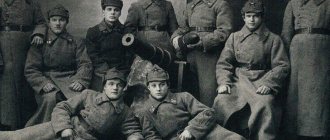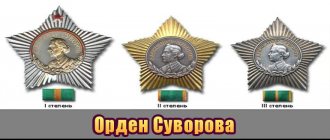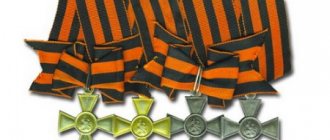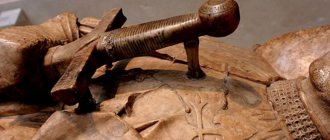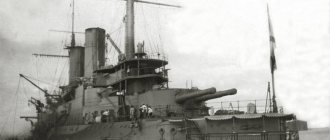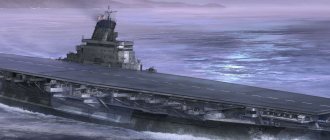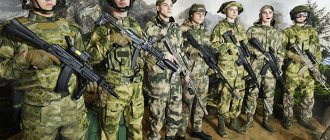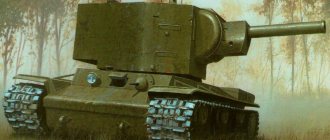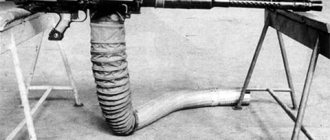The Order of Glory is an unusual military award of the Great Patriotic War. Historians note the similarity of the regalia with royal awards not only in appearance, but also in essence. The statute is distinguished by its careful study, where each feat was described in detail. The Order of Glory was awarded exclusively for personal heroism and courage on the battlefield, and collective awards were not provided.
How was the Order of Glory created?
In August 1943, a group of nine artists presented 25 different sketches of the future order for consideration by the commission. The selected four options were shown to Stalin. Joseph Vissarionovich chose the design of the artist N. Moskalev, which depicted the outline of Field Marshal Bagration against the background of a five-pointed star.
At the very beginning it was planned that the award would contain four degrees. However, Stalin decided that the order would contain three degrees, like the others. And it should be called the Order of Glory, since there is no victory without courage and glorious deeds. The final version of the award was approved in the same autumn of 1943. The order was created in the form of a five-pointed star with a drawing of the Spasskaya Tower, which is framed by a wreath. Below on the red field is the inscription “Glory”.
Detailed description of the insignia
The order is made in the shape of a five-rayed star, and the distance between the tops of the star itself is 46 mm, each of which has a convex surface framed by sides. In the center of the order there is a medallion circle with a bas-relief of the Kremlin tower, on which a ruby star is installed. The lower part of the medallion has a ruby ribbon with the word “GLORY” in capital letters. On both sides of this ribbon, on the inside of the medallion, there are laurel branches, symbolizing victory.
On the central beam there is an eyelet through which a ring is threaded, thanks to which the award is attached to the order block. The order block has a pentagonal shape, and its decoration is made with moiré ribbon, the width of which is 24 mm. The ribbon has three longitudinal stripes of black color, as well as two orange ones, which alternate with each other and symbolize the flame of fire and smoke (St. George Ribbon). A millimeter orange line runs along both edges of the tape. Thanks to the pin located on the back of the medal block, the award is attached to clothing.
The Order of Glory was issued by the number, which was located on the back of the medallion. It must completely coincide with the entry in the order book. Note that the Order of Glory, III degree, was made of silver, the weight of which in the product is about 20.6 g, with a total weight of the award of 23 g.
The central circumference of the medallion of the Order of the 2nd degree is gilded, and the weight of the award and the silver content coincides with the award of the 3rd degree of distinction. The Order of the 1st degree was made of gold of the highest standard, of which the award contains 29 g, with a total weight of 31 g.
What was the Order of Glory, 3rd class, given for?
In November 1943, the order's charter was officially approved, providing for gradual awarding, starting with the 3rd degree. Therefore, the Order of Glory of the 3rd degree of the Great Patriotic War was made of silver, the 2nd degree was made of gold with silver inserts, and the 1st degree was completely gold. The award was given for the fact that the soldiers:
- were the first to break into enemy positions and ensure the success of the combat operation with their own exploits;
- were in a burning tank, continuing the battle;
- in a dangerous situation they saved the banner of military units;
- the fighter destroyed from 10 to 50 enemy soldiers and officers with small arms;
- the Order of Glory, 3rd degree, was awarded to those who blew up 1-3 tanks with grenades on the front line or behind enemy lines;
- being in reconnaissance I was able to obtain valuable information about the enemy;
- shot down 2–4 enemy aircraft;
- during a night battle he shot down up to four enemy aircraft;
- was able to blow up an enemy ammunition depot.
And this is not the entire list of feats for which the Order of Glory was awarded. Soldiers, sergeants or junior officers received this award for brave deeds helping the Red Army defeat the invaders.
Twenty "Victories".
0
The Order of Victory, according to the statute, was awarded to “persons of the highest command of the Red Army for the successful conduct of such military operations on the scale of several or one front, as a result of which the situation radically changes in favor of the Red Army.” This order is one of the most unique awards of the Soviet Union. It was made of platinum, gold, silver, rubies and diamonds. The complexity of the manufacturing process and special technology led to the fact that its production was entrusted to the craftsmen of the Moscow Jewelry and Watch Factory. This is the only Soviet award that was not created at the Mint. The Order of Victory was the only Soviet order that was worn not on the left, but on the right side of the chest. Initially it was assumed that 30 signs of this unique order would be created. In practice, throughout history, the Order of Victory was awarded only 20 times, and one award was subsequently annulled.
0
The first award of the Order of Victory took place on April 10, 1944. The highest award for military leaders was given to three commanders who distinguished themselves during the liberation of Right Bank Ukraine. Order number 1 was received by the commander of the 1st Ukrainian Front Georgy Zhukov, number 2 - Chief of the General Staff Alexander Vasilevsky, number 3 - Supreme Commander-in-Chief Joseph Stalin. The three above were awarded the Order of Victory twice - no one else received such an honor. Among those awarded the Order of Victory were five foreigners who made a significant contribution to the victory in World War II - American general and future US President Dwight Eisenhower, British Field Marshal Bernard Montgomery, Romanian King Michael I, Polish Marshal Michal Rolya-Zimierski and the head of Yugoslavia, Marshal Josip Broz Tito.
How the award was presented
Full holders of the Order of Glory had the right to be awarded the following military ranks. For example, an ordinary soldier, corporal or sergeant could become a sergeant major, those who already had this rank could become a junior lieutenant, and in aviation they could rise to the rank of lieutenant.
The 3rd degree order was awarded to the commanders of such large formations as divisions and corps, the 2nd degree - to the commander of an army or front, and the 1st degree was given only by resolution of the Supreme Council.
Like many orders and medals of the USSR, the Order of Glory was awarded right at the front after the end of a successful military operation. The very first documentary evidence of awarding the order is dated the 20th of December 1943. This award was awarded to the sapper of the 140th Infantry Regiment, Sergeant G. A. Israelyan.
Mysterious Mihai and the “dispossessed” Brezhnev
The Romanian King Mihai I stands out especially among the holders of the Order of Victory. At the time of writing, the 92-year-old ex-monarch is the only living holder of this award. This is not surprising, because at the time of the award in 1945, Mihai was not yet 24 years old. Mihai attended the Victory Parade in Moscow in 2005 and 2010, but he did not wear the Order of Victory. According to the official version, the award is located on the monarch’s estate, in a safe place. According to the unofficial story, Mihai sold the order, and now the award is in a private collection.
Photo: AiF
In the Grand Kremlin Palace, in honor of the holders of the Order of Victory, a special memorial plaque was installed, where they are all listed by name.
The only case when the award of the Order of Victory was canceled was associated with Leonid Brezhnev . In 1978, the aging Secretary General, who, at the end of his career, had an unbridled craving for awards, was awarded the Order of Victory with the wording “for his great contribution to the victory of the Soviet people and their Armed Forces in the Great Patriotic War, outstanding services in strengthening the country’s defense capability, for the development and consistent implementation of the foreign policy of the world of the Soviet state, which reliably ensures the development of the country in peaceful conditions.”
With all due respect to Brezhnev's military merits, he in no way fit the statute of the order, and his award was met with disapproval by front-line soldiers. Many explained that the Order of Victory was awarded to Brezhnev because no other new awards had been invented for him.
After 10 years, Soviet leader Mikhail Gorbachev will decide to cancel the awarding of Brezhnev.
Knights of the Order
Most of those who participated in the Second World War received various military awards, but the Order of Glory became one of the most popular awards among private soldiers, sergeants and officers.
Over the entire period from 1943 to 1945, the number of soldiers awarded this award exceeded 45 thousand people, among whom more than 2,500 soldiers received all three degrees.
In the history of the Second World War, there are known cases when entire battalions were awarded the order for breaking into enemy positions, which led to victory over the enemy in a given direction. Subsequently, such units bore the name “Battalion of Glory”. Among those awarded the order of all 3 degrees there are four Heroes of the USSR and four representatives of the fairer sex.
Awardees
The Medal “For Courage” (the Patriotic War was the most difficult of all wars in world history, and the awarding of this medal during it became widespread) after the Victory ended up in many families of Soviet people. Among those awarded were very young heroes. Thus, the youngest recipient was the 6-year-old son of the regiment, Sergei Aleshkov, who saved his commander. Another teenage soldier, 15-year-old Afanasy Shkuratov, already had 2 such awards by the end of the war. He received the first of them during the battles for the capture of the city of Surozh, when he delivered a wounded officer to the medical battalion, and the second was awarded to him for the courage shown in Karelia, during the operation on the Mannerheim Line.
The Medal “For Courage” (1945 was not the last year when it was awarded) was also awarded to foreign citizens. In particular, in May 1964, the Danes Viggo and Lilian Lindum were awarded for saving the life of a Soviet officer. In addition, on July 8, 1964, this high award was awarded to Czechoslovakian citizen A. Haller, who in the last days of the war conducted the lead Soviet patrol by the shortest route to Prague.
Financial assistance from the state to holders of the order
By decision of the Supreme Council, those awarded this order received monthly subsidies:
- Order of Glory, 1st degree – 15 rubles per month;
- 2nd degree – 10 rubles;
- 3rd degree – 5 rubles per month.
Also, full holders of the Order of Glory had the right to an increased pension in case of loss of ability to work and the opportunity to study for free in universities.
Historical facts about the award
Sailor P. Dubinda served in the Navy in 1941, when the war began. In the summer of 1942, he was seriously wounded and captured. In the spring of 1944, Dubinda fled from the invaders and again joined the army as an ordinary soldier. In August 1944, during an attack on German positions, he broke into an enemy shelter and neutralized 7 enemy soldiers. For this act he acquired the Order of Glory, 3rd degree.
A couple of weeks later, in the battle for a Polish village near Warsaw, Dubinda replaced the wounded platoon commander and successfully led an attack on enemy positions, for which he earned the Order of Glory, 2nd degree.
In October 1944, he managed to exterminate four fascist soldiers and capture a German officer. For this he received an order of the 1st degree.
The second similar hero, who earned all three degrees of the order and the title of Hero, was artilleryman A. Aleshin. In the spring of 1943, about ten enemy tanks were moving towards the gun position, which was held by the battery of the future holder of the order. Three tanks were knocked out, the rest retreated. For this Aleshin acquired the Order of Glory, 3rd degree.
In the winter of 1945, A. Aleshin’s artillery crew near Fansburg repulsed two German counterattacks, inflicting significant damage on the enemy. For this he was awarded the Order of Glory, 2nd degree.
A little later he had to fight off three enemy attacks. The Germans retreated, suffering losses of 40 people killed. And Aleshin was awarded the Order of Glory, 1st degree, for this.
The next famous holder of the order is the pilot I. Drachenko. For the period 1943–1944. He made about 50 sorties on his plane, destroying 3 enemy tanks, 20 vehicles, 4 anti-aircraft guns and more than a hundred enemy soldiers and officers. For this he was awarded the Order of the 3rd degree.
On June 26, 1944, attack pilot I. Drachenko at Tuzira station near the town of Iasi repelled the attack of German planes and destroyed the enemy, for which he was awarded the Order of Glory, 2nd degree.
He acquired the next degree in the fall of 1944 for the combat missions he flew in September-October '44. The total number of flights was more than 50.
Another Hero of the USSR who was awarded the Order of Glory, 3rd degree, was artilleryman N. Kuznetsov, who received all three degrees for the liberation of the city of Sevastopol. He planted the Victory Banner over the station, repelled tank attacks in the Battle of Lithuania and knocked out 10 German tanks near Konigsberg. However, he received the last award only in 1980, although he was awarded in 1945.
